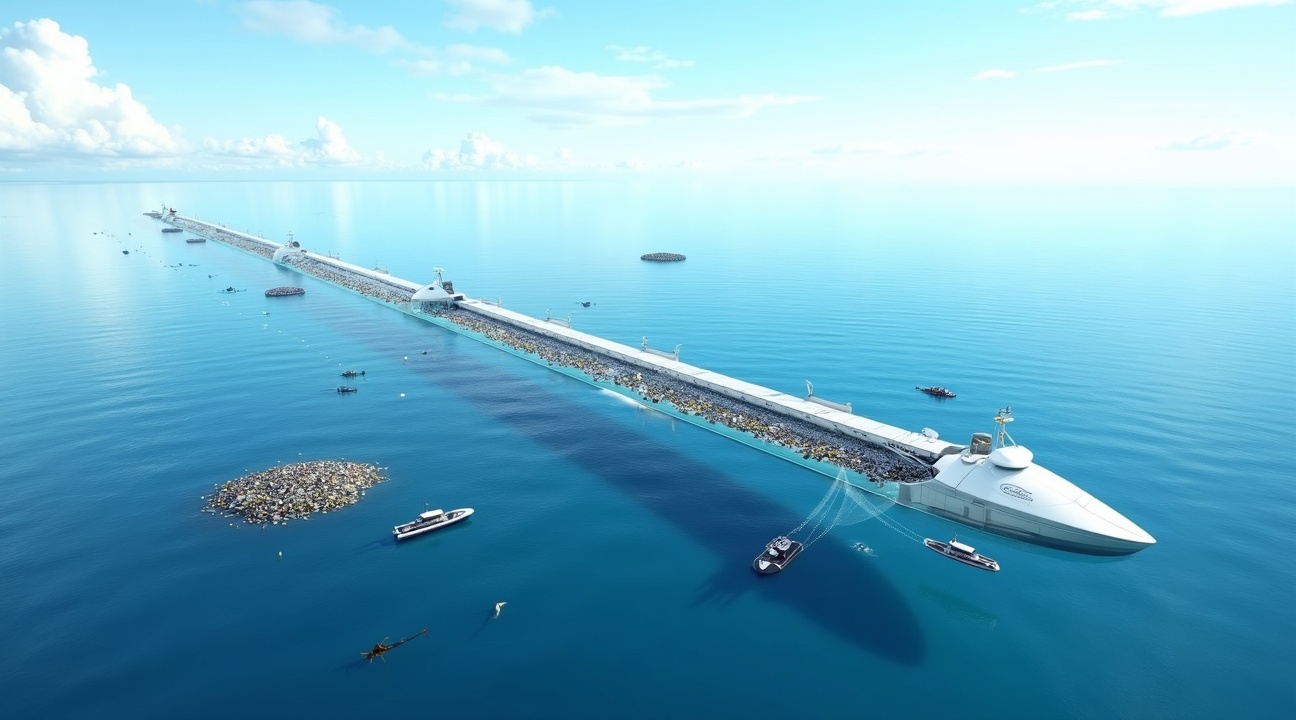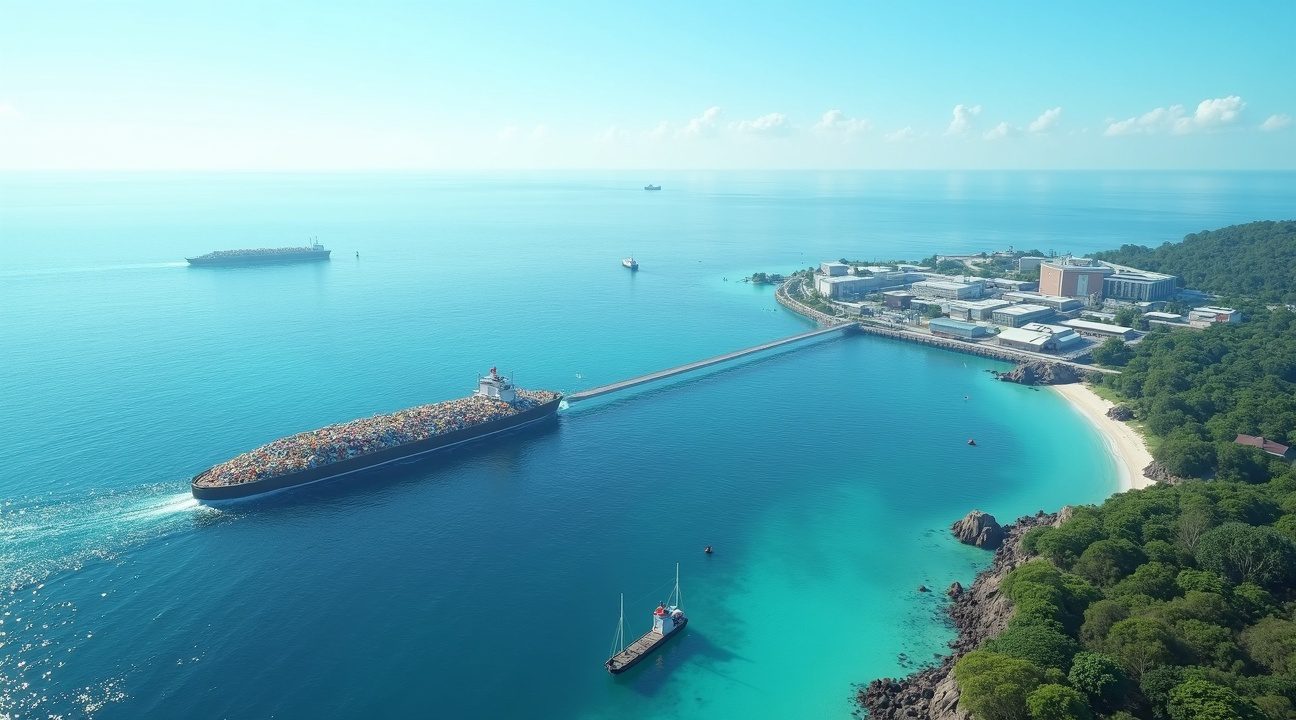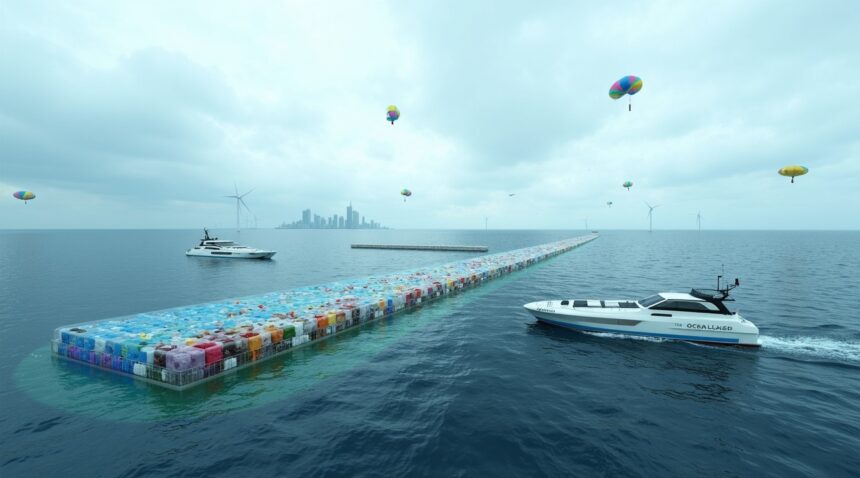Dutch engineers have successfully deployed a revolutionary 600-meter floating device that has already extracted 2,500 tonnes of plastic waste from Pacific waters, demonstrating the practical potential of large-scale ocean cleanup technology.
This passive system, developed by The Ocean Cleanup, uses ocean currents and a parachute sea anchor to create an artificial coastline effect, efficiently capturing plastic debris while operating sustainably without any external power sources.
Key Takeaways
- The Ocean Cleanup’s floating vacuum system has collected 2,500 tonnes of plastic from the Pacific as of July 2024, with the potential to remove over 12 million kg yearly at full operation.
- The passive technology relies entirely on wind, waves, and ocean currents, utilizing a parachute sea anchor and a U-shaped barrier to gather plastic debris.
- Engineers estimate that a fleet of these systems could remove 50% of the Great Pacific Garbage Patch every five years, cutting the projected cleanup time from 80,000 years to a 2040 target.
- Collected plastic is recycled into consumer products such as sunglasses, supporting a circular economy model that turns ocean waste into economic opportunity.
- The Great Pacific Garbage Patch now holds over 100 million floating debris pieces, expanding rapidly with an estimated one truckload of plastic entering the ocean every minute.
Innovative Engineering Behind the Project
System 03: Technological Breakthrough
System 03, the latest version of the cleanup device, stretches 600 meters across Pacific waters. It functions autonomously, using only natural forces such as currents and wind to operate without fuel or electricity.
The system uses a U-shaped float barrier that moves slower than the plastic debris around it. As ocean currents drive debris into the system’s opening, a retention mechanism holds the waste until it can be removed. A sea anchor provides drag, maintaining a stable position and maximizing collection efficiency.
Collection Mechanism and Range
This device captures a wide range of plastics, including tiny 1mm microplastics as well as large ghost nets weighing several tons. Support ships collect accumulated waste every few months for processing onshore, where it is sorted and recycled.
The Scale of the Problem
The Great Pacific Garbage Patch spans an area twice the size of Texas and harbors roughly 100,000 tonnes of plastic debris. Conventional cleanup methods are too slow, potentially taking millennia. In contrast, The Ocean Cleanup’s passive technology offers a massive step forward in both scale and speed.
Economic and Environmental Impacts
Creating Value Through Recycling
By partnering with businesses, The Ocean Cleanup transforms extracted plastic into products such as sunglasses, apparel, and packaging. These items not only reduce environmental waste but also generate funds to sustain the operation, proving the economic viability of large-scale plastic retrieval.
Monitoring Marine Ecosystems
With every system deployment, environmental scientists conduct marine monitoring initiatives. These include tracking wildlife interactions and analyzing bycatch levels, ensuring that biodiversity is protected and the operation remains sustainable. Data so far indicates the environmental impact remains minimal while removing significant plastic mass.
Deploying at Scale and Facing Challenges
Fleet Operations and Costs
For maximum impact, a network of these systems must operate across various ocean regions. Engineers project that deploying ten systems could reduce the Great Pacific Garbage Patch by 50% within five years. However, each device comes with a considerable build and deployment cost of around $20 million.
Ongoing Refinement and Resilience
The systems must withstand harsh weather, logistical complexities, and busy marine traffic. Engineers continuously analyze performance data to improve storm resistance, enhance component durability, and optimize maintenance processes. Ongoing innovation ensures systems stay efficient and reliable over time.
Looking Ahead: A Comprehensive Strategy
Future plans include focusing cleanup efforts upstream in smaller river systems, preventing plastic pollution from ever reaching open oceans. These targeted interventions complement oceangoing systems, forming a full-spectrum approach to managing and reducing plastic pollution at its source.
Measuring Success Beyond Collection
The initiative’s success isn’t measured solely by tonnes collected, but also by improvements in aquatic health and long-term reductions in ocean plastics. With the right investment and deployment scale, this pioneering technology may set a new standard in global ocean conservation.
How an 18-Year-Old Dutch Visionary Created a Global Ocean Cleanup Revolution
I find it remarkable that one teenager’s frustration with plastic pollution during a diving trip in Greece would eventually lead to one of the most ambitious environmental projects of our time. In 2013, Boyan Slat founded The Ocean Cleanup when he was just 18 years old, transforming a high school science project into a groundbreaking initiative that would challenge conventional thinking about ocean plastic removal.
From Teenage Vision to Global Movement
Slat’s journey began with a simple observation: traditional cleanup methods weren’t adequate for the massive scale of ocean plastic pollution. Rather than accepting this limitation, he envisioned a system that could harness ocean currents to collect plastic autonomously. This teenage insight would eventually revolutionize how scientists and engineers approach marine pollution cleanup.
The Ocean Cleanup’s transformation from a one-person vision to a sophisticated operation demonstrates the power of innovative thinking combined with scientific rigor. What started as Slat’s determination to solve an environmental crisis has evolved into a comprehensive research and development organization that attracts top talent from around the world.
Building a World-Class Team in Rotterdam
Today, The Ocean Cleanup operates from its headquarters in Rotterdam, the Netherlands, employing approximately 120 professionals who bring diverse expertise to this complex challenge. The organization’s workforce includes engineers, researchers, calculation modellers, and supporting roles, each contributing specialized knowledge to advance ocean cleanup technology.
Rotterdam’s location as a major port city provides strategic advantages for The Ocean Cleanup’s operations. The city’s maritime infrastructure and engineering expertise create an ideal environment for developing and testing large-scale ocean cleanup systems. This Dutch engineering hub has become the epicenter for innovations that could fundamentally change how humanity addresses plastic pollution in our oceans.
The non-profit structure of The Ocean Cleanup reflects Slat’s original mission: developing advanced technologies to rid oceans of plastic waste rather than pursuing profit. This approach has enabled the organization to focus entirely on solving technical challenges and scaling effective solutions. The team’s dedication to this mission has attracted funding from philanthropists, corporations, and individuals who recognize the urgent need for ocean cleanup innovation.
The organization’s growth trajectory illustrates how visionary leadership can mobilize resources and talent around a critical environmental challenge. From Slat’s initial concept to today’s sophisticated operation, The Ocean Cleanup has maintained its focus on developing practical, scalable solutions that can make a measurable impact on ocean plastic pollution.
Dutch engineering excellence has played a crucial role in transforming Slat’s vision into reality. The Netherlands’ strong tradition in hydraulic engineering and marine technology provided the foundational expertise necessary to tackle the complex challenges of ocean cleanup. This technical heritage, combined with innovative thinking, has enabled The Ocean Cleanup to develop systems that can withstand harsh ocean conditions while effectively collecting plastic waste.
The organization’s approach to advanced plastic removal technology goes beyond simple collection methods. Research teams continuously refine their understanding of ocean dynamics, plastic behavior, and system optimization. This scientific foundation ensures that cleanup efforts are both effective and environmentally responsible.
The Ocean Cleanup’s evolution from a teenage idea to a global operation demonstrates how young innovators can drive significant environmental progress. Slat’s willingness to challenge established approaches and pursue ambitious solutions has inspired a new generation of environmental entrepreneurs. The organization’s success shows that age doesn’t limit one’s ability to create meaningful change when vision is combined with scientific rigor and persistent effort.
Rotterdam continues to serve as the launching point for ocean cleanup innovations that capture global attention, much like how other groundbreaking projects have emerged from unexpected places, similar to revolutionary space exploration initiatives that have redefined what’s possible in their respective fields.
The Ocean Cleanup Has Already Pulled 2,500 Tonnes of Plastic from the Pacific
Dutch engineers have achieved remarkable progress with their revolutionary ocean cleanup system, successfully extracting 2,500 tonnes of plastic waste from Pacific waters as of July 2024. This massive floating device demonstrates the practical potential of large-scale ocean cleanup technology, proving that ambitious environmental engineering can deliver tangible results.
The system’s engineering excellence lies in its ability to endure harsh ocean conditions while maintaining collected plastic for extended periods. Unlike previous attempts that struggled with retention, this 600-meter floating array keeps captured debris secure until collection vessels arrive. The design withstands powerful currents, storms, and the corrosive marine environment that has challenged similar innovative engineering projects in the past.
Projected Impact and Operational Scale
Once the system reaches full operational capacity, engineers expect it to harvest over 12,000,000 kg of plastic during its first year. This staggering figure represents a significant step forward in addressing ocean pollution on an industrial scale. The technology’s efficiency comes from its passive collection method, which uses ocean currents to funnel plastic debris into concentrated collection zones.
The long-term vision extends far beyond single-system deployment. A complete fleet of these ocean vacuum devices could remove 50% of the Great Pacific Garbage Patch every five years. This projection transforms ocean cleanup from a theoretical concept into a measurable, time-bound objective.
The cleanup strategy operates on two fronts:
- Intercepting plastic at river sources before it reaches the ocean
- Removing existing accumulation from established garbage patches
River interception prevents new pollution from entering marine environments, while ocean-based systems tackle the massive plastic accumulation that has built up over decades.
This dual approach addresses both immediate symptoms and long-term prevention. River systems contribute approximately 80% of ocean plastic pollution, making upstream intervention crucial for sustained impact. Meanwhile, the floating ocean systems target concentrated areas where currents have accumulated debris over years.
Engineers have optimized the system’s collection efficiency through careful study of ocean current patterns and plastic distribution. The device positions itself strategically within natural convergence zones where plastic naturally accumulates, maximizing collection rates while minimizing energy consumption.
The success of this technology offers hope for scaling ocean cleanup efforts globally. Other polluted marine areas could benefit from similar systems, adapted to local current patterns and debris concentrations. The proven track record of 2,500 tonnes collected provides concrete evidence that engineering solutions can address environmental challenges previously considered insurmountable.

Revolutionary Passive Technology Captures Everything from 1mm Microplastics to Massive Ghost Nets
System 001/B launched from Vancouver in June 2019, marking a pivotal moment in ocean cleanup technology. I’ve witnessed how this innovative approach harnesses the ocean’s own forces to solve one of humanity’s most pressing environmental challenges. The system demonstrates remarkable versatility by successfully capturing plastics across all size classes, from microplastics as small as 1mm to enormous ghost nets that span hundreds of meters.
The genius lies in the passive collection technology that works with natural ocean forces rather than against them. Winds, waves, and currents drive the entire operation, eliminating the need for external power sources or fuel consumption. This approach makes the system both environmentally sustainable and cost-effective for long-term ocean cleanup operations.
How the Parachute Sea Anchor Creates an Artificial Coastline
The system’s most ingenious feature is its parachute sea anchor, which slows down the device while allowing faster-moving plastic debris to flow into the collection area. Picture how debris naturally accumulates along coastlines — this technology recreates that phenomenon in the open ocean. The floating barriers span hundreds of meters, essentially functioning as an artificial coastline that concentrates plastic waste.
Key components of this passive system include:
- A U-shaped barrier that creates a collection zone for plastic debris
- The parachute sea anchor that controls drift speed and maintains optimal positioning
- Cork-line floatation that keeps the barrier at the surface while the screen extends underwater
- Modular sections that allow for offshore modifications and improvements based on real-world performance
The modular design proves particularly valuable because it enables engineers to make adjustments without returning the entire system to port. This flexibility has allowed continuous optimization based on field data and changing ocean conditions. Each module can be modified independently, ensuring the system adapts to different types of plastic accumulation patterns.
What makes this technology truly revolutionary is its ability to concentrate debris that would otherwise remain dispersed across vast ocean areas. The system moves slower than the plastic due to its sea anchor, creating a situation where debris naturally funnels into the collection area. This passive approach means the device can operate continuously without human intervention or mechanical breakdowns that plague active collection systems.
The artificial coastline technology has proven effective in capturing everything from tiny microplastic fragments to massive fishing nets. Ghost nets, which pose serious threats to marine life, become trapped in the system’s barriers just as effectively as smaller debris. This comprehensive collection capability addresses the full spectrum of ocean plastic pollution rather than targeting specific size categories.
Recent field tests have validated the system’s ability to maintain its position and continue collecting debris even in challenging weather conditions. The modular design’s resilience has been tested through Pacific storms, demonstrating that passive collection technology can withstand the harsh marine environment while continuing operations.
Engineers have continuously refined the system based on deployment data, adjusting barrier heights, sea anchor configurations, and collection mechanisms. These offshore modifications have improved collection efficiency without requiring complete system redesigns. The ability to adapt and improve while deployed represents a significant advantage over traditional cleanup approaches that require extensive shore-based modifications.
The success of System 001/B has proven that large-scale ocean cleanup is possible using environmentally friendly passive technology. By working with ocean forces rather than fighting them, this approach offers a sustainable path forward for addressing the millions of tons of plastic waste contaminating our oceans. The system’s demonstrated ability to capture debris across all size ranges makes it a comprehensive solution for ocean plastic pollution.
Learn more about this initiative at The Ocean Cleanup.
Tackling the World’s Largest Ocean Garbage Dump That Grows by One Truck Load Every Minute
The Great Pacific Garbage Patch represents humanity’s most visible environmental failure, stretching across an area larger than most countries. This massive accumulation zone contains over 100,000,000 pieces of floating plastic debris, creating a concentrated nightmare that threatens marine ecosystems across the Pacific Ocean.
I observe how the scale of this crisis extends far beyond what most people imagine. Currently, more than 150 million tonnes of plastic pollute global oceans, transforming pristine waters into floating landfills. The situation worsens dramatically each day, with an estimated 11 million tonnes added annually—equivalent to more than one full lorry load dumped into our oceans every single minute.
The Devastating Impact on Marine Life and Human Health
Trillions of pieces of plastic pollute oceans globally, creating a crisis that affects every level of marine life. Large marine animals often mistake plastic debris for food, leading to internal injuries, starvation, and death. Sea turtles confuse plastic bags with jellyfish, while seabirds fill their stomachs with bottle caps and fragments instead of nutritious fish.
The problem goes deeper than visible debris. Microplastics break down from larger pieces, infiltrating the entire food chain. These microscopic particles carry toxic chemicals that accumulate in fish tissues, eventually reaching human dinner plates. Scientists have discovered microplastics in drinking water, salt, and even human blood samples, demonstrating how ocean pollution directly impacts human health.
Marine wildlife faces additional threats from entanglement in plastic debris. Fishing nets, rope, and plastic rings trap dolphins, whales, and seals, preventing them from feeding or breathing properly. Ghost nets continue fishing long after abandonment, creating underwater death traps that operate for decades.
The economic impact extends beyond environmental concerns:
- Coastal communities lose tourism revenue when beaches become littered with plastic waste.
- Fishing industries struggle as catch quality decreases and equipment gets damaged by debris.
- Global food security suffers as fish populations decline and contamination spreads throughout marine ecosystems.
Food chain contamination represents perhaps the most alarming aspect of ocean plastic pollution. Plankton, the foundation of marine food webs, consume microplastics and pass them up through increasingly larger predators. This bioaccumulation means that apex predators, including commercially important fish species, contain the highest concentrations of plastic-derived toxins.
The Dutch engineering solution addresses this escalating crisis with innovative technology designed specifically for the unique challenges of ocean cleanup. Traditional cleanup methods prove inadequate for the scale and location of the Great Pacific Garbage Patch, making revolutionary approaches essential for meaningful progress against this environmental disaster.
https://www.youtube.com/watch?v=PlhWkIStL4k
The Bold 2040 Plan to Eliminate 90% of Ocean Plastic and Create Valuable Products
The Ocean Cleanup organization has set an ambitious target that sounds almost impossible: reducing 90% of all floating ocean plastic worldwide by 2040. I find their approach particularly compelling because they’ve designed their mission with a unique endpoint — to literally put themselves out of business once the oceans are clean.
From Waste to Wealth: The Circular Economy Approach
The collected plastic doesn’t simply disappear into landfills. Instead, the organization returns all collected material to land for recycling into valuable raw materials and durable products. This approach creates a sustainable circular economy model that transforms ocean pollution into economic opportunity.
As proof of this concept, The Ocean Cleanup created their signature sunglasses, demonstrating how ocean plastic can become high-quality consumer products. These sunglasses serve as tangible evidence that waste from the Pacific can be converted into desirable items people actually want to purchase.
The organization plans extensive collaboration with companies for large-scale plastic-to-product conversion. This strategy ensures that the massive volumes of plastic collected by their 600-meter floating systems won’t overwhelm recycling facilities. By partnering with manufacturers, they’re building the infrastructure needed to handle tons of recovered material efficiently.
I believe their sustainable product development strategy addresses a critical challenge in ocean cleanup efforts. Previous initiatives often focused solely on collection without considering what happens to the waste afterward. This comprehensive approach creates economic incentives that could drive additional investment in cleanup technologies.
The 2040 timeline might seem aggressive, but the organization’s systematic approach suggests they’re serious about achieving 90% plastic reduction. Their floating vacuum systems continue to prove effective in the Pacific, and each successful deployment brings them closer to scaling operations globally.
Much like how SpaceX revolutionized space exploration, The Ocean Cleanup is transforming how we think about environmental remediation. Rather than viewing ocean plastic as an insurmountable problem, they’ve reframed it as a resource waiting to be harvested and repurposed.
Their circular economy model could inspire similar initiatives across different environmental challenges. When organizations can generate revenue from cleanup activities, it creates a self-sustaining cycle that doesn’t rely solely on donations or government funding.
The combination of innovative technology, clear timelines, and economic viability positions this initiative as one of the most promising approaches to addressing ocean plastic pollution. Their commitment to working themselves out of a job demonstrates the kind of thinking necessary to solve global environmental challenges.

From 80,000-Year Timeline to 2040 Goal Through Breakthrough Engineering Innovation
When Dutch engineers first calculated the timeline for cleaning the Great Pacific Garbage Patch using conventional methods, the results were staggering. Computer models revealed that traditional approaches would require approximately 80,000 years to address the massive accumulation of plastic debris floating in the Pacific Ocean. This calculation served as a wake-up call that sparked revolutionary thinking about ocean cleanup technology.
Revolutionary Engineering Approach
The Ocean Cleanup foundation refused to accept this timeline and embarked on developing an entirely different approach. Instead of sending boats to collect plastic piece by piece, engineers designed a passive system that would use ocean currents to concentrate the waste. This fundamental shift in methodology reduced the projected cleanup time from 80,000 years to an ambitious target of completing the task by 2040.
System 002, currently under development, represents the culmination of years of testing and refinement. This next-generation cleanup system incorporates lessons learned from extensive prototype testing and real-world deployment experiences. Engineers have focused on creating a full-scale system capable of withstanding the harsh conditions of the open ocean while efficiently collecting plastic debris of various sizes.
Rigorous Testing and Development Process
The path to System 002 involved comprehensive testing phases that validated the engineering concepts under real ocean conditions. The development process included several critical components:
- Reconnaissance expeditions to map plastic concentrations and understand ocean dynamics
- Scale model testing in controlled environments to validate design principles
- North Sea prototype deployment to test systems in actual marine conditions
- Continuous monitoring and data collection to optimize performance parameters
- Iterative design improvements based on operational feedback
North Sea testing proved particularly valuable for system validation. Engineers deployed prototypes in these challenging waters to evaluate how the systems performed under various weather conditions and sea states. The data collected during these trials directly influenced the design specifications for System 002, ensuring the technology could handle the demanding environment of the Pacific Ocean.
Each testing phase revealed new insights about ocean behavior and system performance. Engineers discovered that plastic debris behaves differently than initially modeled, leading to design modifications that improved collection efficiency. The continuous feedback loop between testing and development has been crucial for achieving the dramatic timeline reduction from 80,000 years to the 2040 goal.
Real-world performance data has driven ongoing system improvements throughout the development process. Engineers analyze every aspect of system operation, from the behavior of the collection barrier to the efficiency of waste extraction. This data-driven approach ensures that each iteration of the technology performs better than the previous version.
The engineering innovation behind this timeline compression demonstrates how breakthrough thinking can transform seemingly impossible challenges into achievable goals. By rejecting conventional approaches and embracing radical new concepts, the Dutch team has created a pathway to address one of the ocean’s most pressing environmental challenges within a reasonable timeframe. Much like other ambitious projects in space exploration, this initiative shows how engineering innovation can accelerate solutions to complex global problems.
System 002 represents more than just technological advancement; it embodies a complete rethinking of how humans can interact with and restore ocean ecosystems. The extensive testing and development process has created a foundation for scaling cleanup operations across multiple ocean gyres, potentially addressing plastic pollution on a global scale by 2040.
https://www.youtube.com/watch?v=odFhZy0joHg
Sources:
The Ocean Cleanup Official Website


